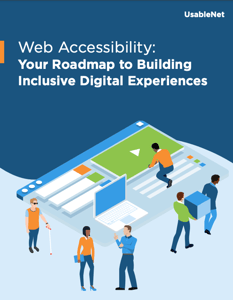Building an accessibility-first culture within your business requires intentional effort. To help you streamline their accessible culture and digital presence at the same time, we’ve developed an effective 3-phase integrated approach. The last phase being ADA monitoring, which must be done continually long-term.
Let’s take a look at the three phases you should follow when building an accessibility-first culture.
1. Start By Improving High-Visibility Accessibility AreasWhen you first start on our accessibility journey, you’re going to want to focus on high-visibility areas in your digital presence first.
The core challenge you’ll face here is that this digital accessibility will be new to almost everyone. There may be a general lack of knowledge and understanding. To alleviate this, consider doing the following:
- Focus on how to increase knowledge within teams about digital accessibility
- Collect and document issues from all reviews into one place
- Make it easy for your team to recreate the issues
- Know which digital accessibility issues need to be addressed by which team
The Actions You’ll Take
During this stage, you may want to take the following steps:
- Assess all digital experiences, including your website, mobile apps, videos, and pdfs
- Look at high-visibility experiences like your homepage, navigation, and top tasks
- Perform individual tests with screen readers, keyboard-only navigation, and an automated testing tool
- Start developing a digital accessibility training program for your teams
- Connect to a digital accessibility subject matter expert
The Documentation You Need
Tracking your web accessibility efforts through thorough documentation will keep your team on the same page. It may also help you defend against ADA digital accessibility lawsuits.
Make sure to do the following at this stage:
- Draft your accessibility statement and policy
- Prepare the General Executive Summary, which will dive into resource allocation
- Detail the list of issues that need to be fixed
- Compile initial feedback from user testers on major barriers
2. Implement Major Accessibility Changes at a Core Level
Phase two is where you fix the big stuff, getting things into a really strong accessible state. The details are ironed out, and your digital presence is in good standing.
You may experience the following challenges at this stage:
- Limited time and resources available, requiring high-level buy in to prioritize accessibility
- Major UX changes may be needed install of small quick fixes
- Specialized knowledge may be needed for more complex fixes
- The need to organize multiple different teams responsible for different site aspects
- Updating the operating process so accessibility is part of the standard release process
The Actions You’ll Take
During phase two, these are some of the actions you’ll want to take:
- Complete a WCAG audit using automated and manual techniques to find every issue, particularly with user testing from members of the disability community
- Integrate reporting into a ticket-based system
- Prioritize remediation based on high-visibility and high-barrier issues
- Establish teams responsible for different accessibility concerns
(Check out this related blog post on who's responsible for common web accessibility issues)
The Documentation You Need
While you’re in the second phase of your accessibility journey, make sure to document the following:
- Publish your accessibility statement online
- Pre- and post-audit summary creation to show the improvement and efforts made
- Document verification from users in the disability community
- Review third-party content
3. Continually Monitor Your Site & Assess New Updates
Phase three is about continual and ongoing monitoring for your entire digital presence. The last thing you want to do, after all, is to put all this effort into your site and mobile apps and then fail to maintain it.
The most significant challenges at this phase include:
- You need to track and document all efforts made overtime to support legal records
- Ongoing testing with screen reader users will be essential with every update
- You need to catch high visibility or severity WCAG violations before each release
The Actions You’ll Take
In order to maintain accessibility and compliance long-term, you’ll want to take the following steps during phase three:
- Prioritize accessibility during new projects
- Build UX personas and Dev standards
- Establish regular user testing schedules (like monthly, or with every release)
- Set up WCAG automated monitoring of your top ten pages
- Provide a simple way for users to report issues
The Documentation You Need
Documentation is just as crucial at this phase as it has been for the other two, and should include the following:
- Create internal policies and processes that are recorded for your team including release criteria, customer support escalation of issues, internal UI/UX, and Dev guidelines
- Distribute regular reports for all stakeholders
- Make accessibility a part of your contracts with vendors
With any new project, make sure people are thinking about accessibility as part of that project. Example: If you are working on a new mobile app and testing, you should be testing with people with disabilities.
Why Create a Positive Culture around Digital Accessibility?
There are plenty of reasons why digital accessibility should be a part of your culture and every aspect of your business. Digital accessibility is good for your brand and good for innovation. In a world where 1 in 4 people have disabilities and the Covid-19 pandemic has accelerated technology adoption, it's increasingly good for business. With ADA digital lawsuits predicted to reach an all-time high, an accessibility-first focus can help you reduce your legal risk.
Finally, accessibility is something that if you do it correctly, helps everyone. It's the foundation for a great, usable experience. With an accessibility-first culture, digital accessibility becomes a part of your brand’s DNA. This is how you’ll see the biggest success from your efforts.
Ready to get started with digital accessibility? UsableNet's Accessibility as a Service provides everything your team needs to be successful in making and maintaining your websites and app compliant with ADA/WCAG. Contact us to learn more.
Read more about web accessibility as a 3-phase approach in our e-book, Web Accessibility: Your Roadmap to Building Inclusive Digital Experiences.

.jpg)





